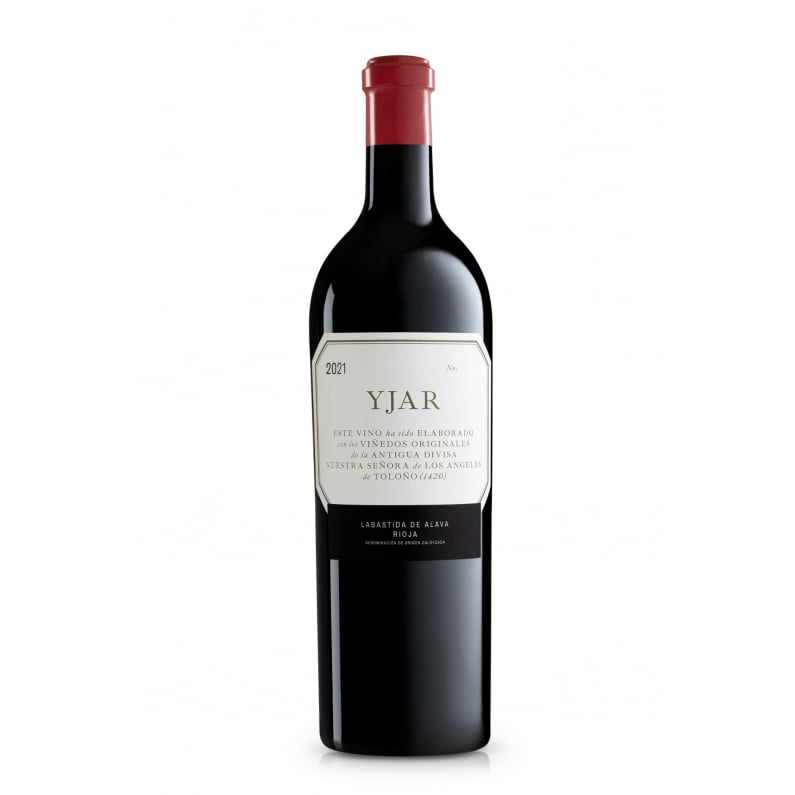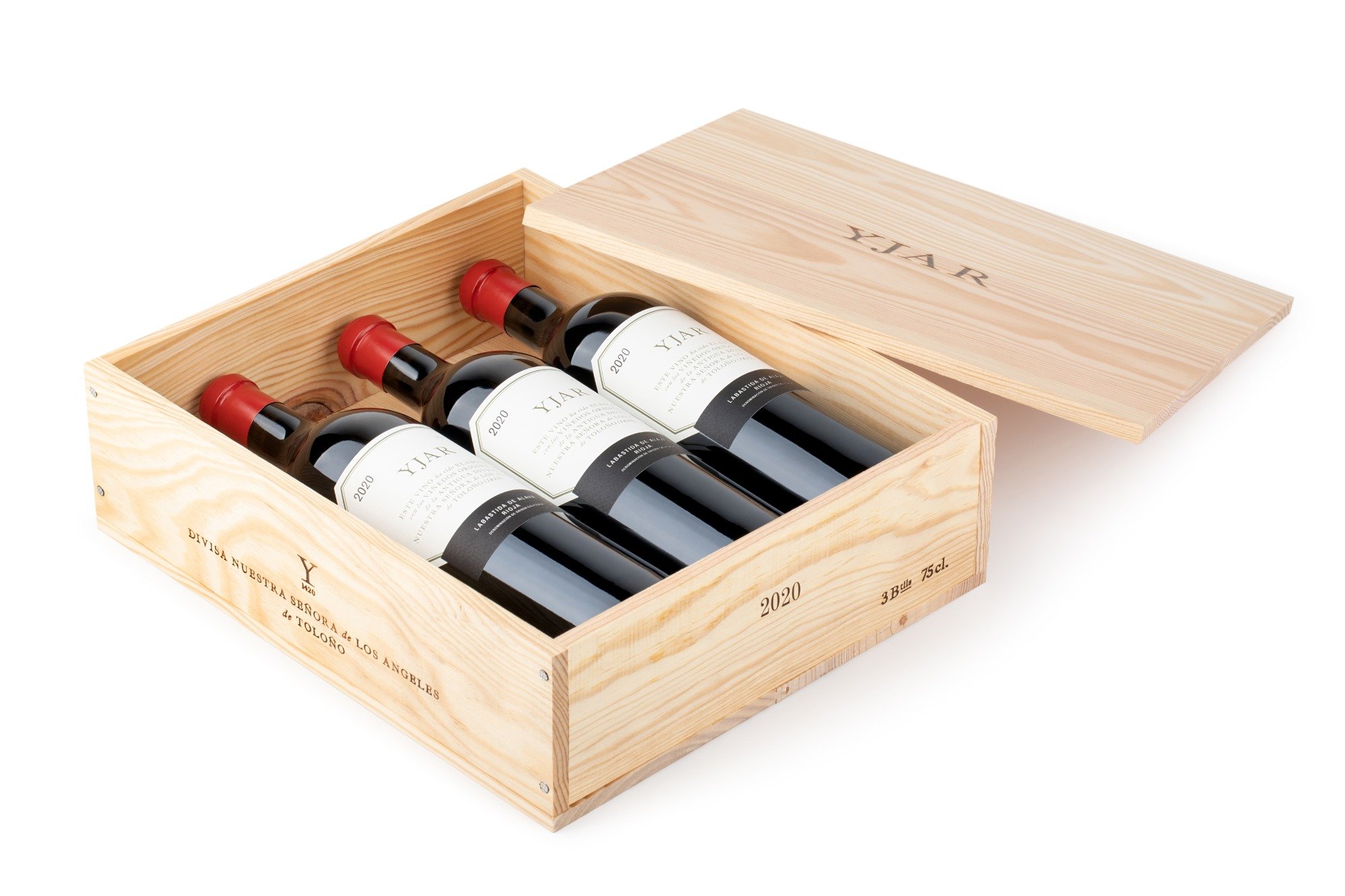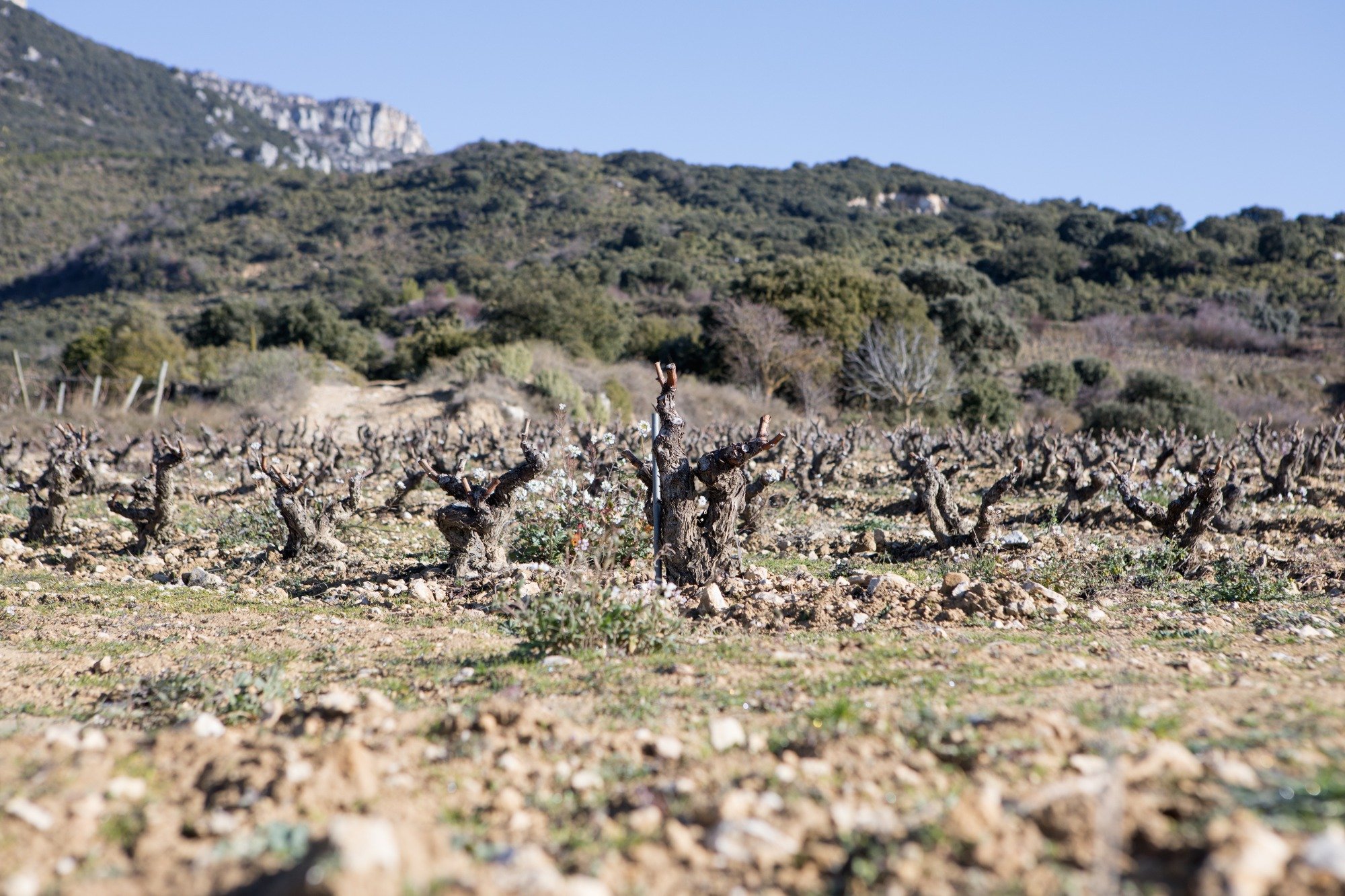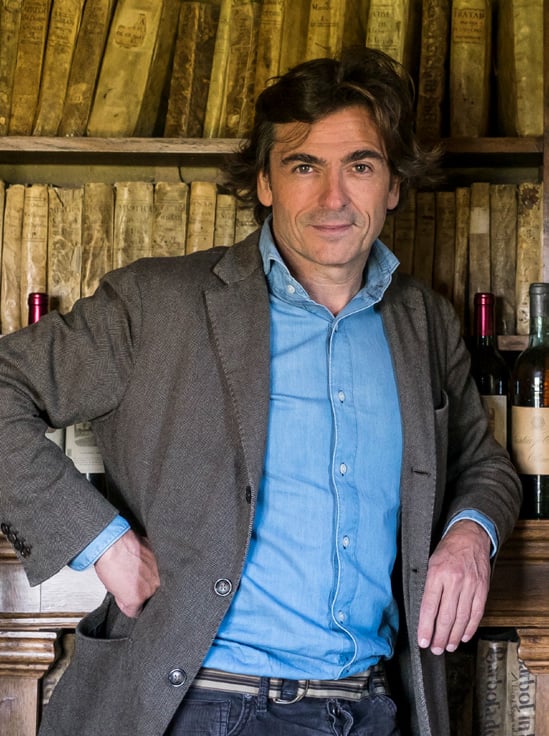2020 Telmo Rodriguez Yjar

De specificaties zoals vermeld bij de wijn (o.a. wijnjaar) en in de titel zijn leidend en er kunnen geen rechten worden ontleend aan de afbeelding die wordt getoond. Lees meer in onze Frequenty asked questions
| Type of Wine | |
|---|---|
| Country | Spain |
| Region | |
| Appellation | |
| Winery | |
| Vintage | 2020 |
| Grape | , , |
| Content (Alc) | 0.75 ltr (14%) |
| Drink window | 2025 - 2038 |
In stock
26 items available
Description
The new top class of Telmo Rogriguez is the Yjar. It is a top red wine produced with Tempranillo and a significant amount of Garnacha grapes from selected soils of Remelluri. This is a separate project and with a different style than Remelluri (maybe closer to the style of Telmo Rodríguez's personal wines and is a wine that will be sold/distributed through the Place de Bordeaux, but they will not sell it under the name Remelluri but under Yjar. FUN FACT: The Yjar was the first Spanish wine to be sold through the Place du Bordeaux .
The Yjar has a more modern profile than the other wines from Remelluri, with more refined tannins, a wine that is different, riper and more powerful, with the depth of the Remelluri wines. It is spicy and peppery, long and chewy with a long finish marked by the limestone of the soil. The Yjar has ripe red with plums, figs, dark chocolate, walnuts and cloves. Full with round and layered tannins that show ripeness and intensity. Fruit-forward, but shaped and powerful. Telmo makes this Yjar from a 3.8 hectare vineyard. It is a field blend of tempranillo, graciano, garnacha, granegro and rojal. Shows the ripeness of the vintage with structure and freshness.
FACT : In the Tab: Attachment you will find the official fact sheet of this beautiful wine and all kinds of information such as a presentation and photos. We will automatically send you this when you order this wine. The wine is in our conditioned Wine Warehouse and if you come to pick up the wine you will often also receive a nice discount. You will see the possible discount immediately if you choose Pick up on the Checkout page. We are located almost next to the Rijksweg with plenty of parking space. Click here for address.
Ratings: 96 Jane Anson, 96+ Wine Advocate, 97 The Drinks Business (Colin Hay)



Specifications
| Packing information | Box |
|---|---|
| Type of Wine | Red |
| Country | Spain |
| Region | Rioja |
| Appellation | Rioja |
| Icons | Icon Spain & Portugal |
| Winery | Telmo Rodriguez |
| Grape | Garnacha, Graciano, Tempranillo |
| Biological certified | No |
| Natural wine | No |
| Vegan | No |
| Vintage | 2020 |
| Drinking as of | 2025 |
| Drinking till | 2038 |
| Alcohol % | 14 |
| Alcohol free/low | No |
| Content | 0.75 ltr |
| Oak aging | Yes |
| Sparkling | No |
| Dessert wine | No |
| Closure | Cork |
| Parker rating | 97 |
| James Suckling rating | 98 |
| Tasting Profiles | Aards, Complex, Droog, Houtgerijpt, Krachtig, Kruidig, Rood fruit, Tannines, Vol |
| Drink moments | Indruk maken, Lekker luxe, Open haard, Romantisch |
Professional Reviews
Parker
The Wine Advocate
RP 96+
Reviewed by:
Luis Gutiérrez
Release Price:
$175
Drink Date:
2025 - 2034
The nose of the 2020 Yjar developed very floral notes with time in the glass, making it very aromatic, expressive and elegant. This is completely different from the other two reds, as this comes from a specific plot. It reveals the finesse of the marl soils and the austerity of the stones. It was a year of sorting and discarding (they had hail) to achieve the consistency they look for in this wine. The different varieties co-planted in the vineyard fermented together (there's more Garnacha here) in open-top oak vats with indigenous yeasts. The wine matured in foudres and barrels of different sizes for approximately 30 months. It's elegant and clean, with a seamless palate, very fine tannins and a vibrant mouthfeel. 12,656 bottles produced. It was bottled in May 2023.
There have been gradual changes in the wines from Remelluri since Telmo and Pablo Eguzkiza returned there in 2010. The new wines come from the 2020 harvest when they reduced quantities tremendously. They probably did less than 200,000 kilos of grapes in 2020; they had done up to 400,000 kilos in the past. There are only two reds and one white, plus the Yjar sold through the Bordeaux négociant system that I tasted in late January 2024. These are completely different from the wines produced in the past, and they don't have anything in common with the Lindes project. The two new reds, a first and a second wine are still unnamed, and the release date has not yet been decided.
Published: Feb 29, 2024
Lorem ipsum dolor sit amet, consectetur adipiscing elit. Sed do eiusmod tempor incididunt ut labore et dolore magna aliqua...
James Suckling
Score
98
Avg Price (ex-tax)
$ 135
Yjar Rioja 2020
Saturday, Aug 31, 2024
Color
Red
Country
Spain
Region
La Rioja
Vintage
2020
Download Shelftalker
The minerality offers a thin gauze that veils the notes of chalk, seashells, violets, white pepper, flowers and red and blue berries. Touches of graphite, spices and grapefruit zest as well. The tannins are dusty and abundant, melding into the extremely long, mineral finish. Transparent, pure and stony! Pristine and understated, yet complex and persistent. This is a chalky wine. 12,652 bottles. Drink from 2025, but you can keep this for 20 plus years.
Zekun Shuai
Senior Editor
Lorem ipsum dolor sit amet, consectetur adipiscing elit. Sed do eiusmod tempor incididunt ut labore et dolore magna aliqua...
Exclusive Content
Sign in to unlock professional wine reviews from world-renowned critics
Wijnhuis
Winemaker Telmo Rodriguez is labeled as one of the young lions of the Spanish wine industry. He studied at the University of Bordeaux and later in the Rhône with the famous August Clape. He was the winemaker of La Granja Senora De Remelluri, his father's bodega in Rioja. He left there to become what some would call a flying winemaker. However, Telmo prefers to call itself a 'driving winemaker'. he lives in Madrid and drives his car to the areas where he makes wine. In a short time his wines have found a place on the international playing field. One example: in Tom Stevenson's Wine Report 2008, Telmo is included among the top 10 producers from Spain. We once again spoke extensively with Telmo Rodriguez. That is always a pleasure. If you sit down with him you always learn something or he gives food for thought. What makes this 'conscience of the Spanish wine world' so special? When Telmo completed his studies in Bordeaux and then had internships with people like Chave (Hermitage), Clape (Cornas) and Dürrbach (Trévallon) he came back to Spain. There he saw other Spaniards who had studied in France bringing French grape varieties and customs to Spain. For example, there was more and more wire guidance, while the Spanish system had always been free-standing sticks. Telmo concluded that he wanted to focus on the old qualities of Spain such as freestanding sticks, indigenous grape varieties and field blends. In addition, he was the first in Spain to introduce modern labels and he opposes the rigid Spanish wine laws.
Free standing sticks
Spain used to be a country of bush vines: the sticks were so far apart per area and per vineyard that they could each get enough water. If you place your sticks far apart with wire articulation, the stick will grow far and become much too large. With wire articulation, you therefore need many more sticks per hectare. However, the problem is that there is not enough water for this and you therefore have to irrigate, in areas that often already suffer from a shortage of water. In addition, the grapes hang more in the shade with free-standing sticks, which gives less chance of 'burning' and leads to less stewed fruit and fresher acids. The only downside to free-standing canes is that more manual work is involved in vineyard management and harvesting. Telmo works almost exclusively with bush vines.
Native grape varieties
It was clear to Telmo that there are so many good indigenous varieties in Spain that importing 'the big five' (Chardonnay, Sauvignon Blanc, Merlot, Cabernet and Syrah) from France was not necessary at all. He was one of the first to produce good Rueda from Verdejo and Viura, he embraced Mencia and Godello in Valdeorras, Monastrell in Alicante, Moscatel in Malaga, Garnacha in Cebreros…. In the mid-1990s he was still considered crazy with this philosophy, but now everyone is following him.
Field blends
There used to be many vineyards in Spain with various grape varieties mixed together, also called 'field blends'. It is often argued against field blends that the varieties (that are picked together) are not all ripe at the same time. It speaks for the fact that diversity and disease resistance increase and that it promotes complexity. Telmo now has two vineyards with field blends in production. In Rioja he makes it Las Beatas (named after the vineyard, first vintage awarded with 97 points by Parker) and in Valdeorras Las Caborcas. Beautiful, original wines!
Spanish wine laws
Telmo was the first to remove the word Reserva from a Rioja in 1995. In his words: 'I ask my wines how long they want to stay in the wood'. One year grapes can easily handle a 12-month aging in wood, but not in another year. There was consternation about Las Beatas: the Consecho initially did not want to approve the wine made with a field blend as Rioja… while there was a time when all Rioja was made that way! Consecho did not push this to the extreme and ultimately fortunate for them, given the enormously high international appreciation.
The new top class of Telmo Rogriguez is the Yjar. It is a top red wine produced with Tempranillo and a significant amount of Garnacha grapes from selected soils of Remelluri. This is a separate project and with a different style than Remelluri (maybe closer to the style of Telmo Rodríguez's personal wines and is a wine that will be sold/distributed through the Place de Bordeaux, but they will not sell it under the name Remelluri but under Yjar. FUN FACT: The Yjar was the first Spanish wine to be sold through the Place du Bordeaux .
The Yjar has a more modern profile than the other wines from Remelluri, with more refined tannins, a wine that is different, riper and more powerful, with the depth of the Remelluri wines. It is spicy and peppery, long and chewy with a long finish marked by the limestone of the soil. The Yjar has ripe red with plums, figs, dark chocolate, walnuts and cloves. Full with round and layered tannins that show ripeness and intensity. Fruit-forward, but shaped and powerful. Telmo makes this Yjar from a 3.8 hectare vineyard. It is a field blend of tempranillo, graciano, garnacha, granegro and rojal. Shows the ripeness of the vintage with structure and freshness.
FACT : In the Tab: Attachment you will find the official fact sheet of this beautiful wine and all kinds of information such as a presentation and photos. We will automatically send you this when you order this wine. The wine is in our conditioned Wine Warehouse and if you come to pick up the wine you will often also receive a nice discount. You will see the possible discount immediately if you choose Pick up on the Checkout page. We are located almost next to the Rijksweg with plenty of parking space. Click here for address.
Ratings: 96 Jane Anson, 96+ Wine Advocate, 97 The Drinks Business (Colin Hay)



| Packing information | Box |
|---|---|
| Type of Wine | Red |
| Country | Spain |
| Region | Rioja |
| Appellation | Rioja |
| Icons | Icon Spain & Portugal |
| Winery | Telmo Rodriguez |
| Grape | Garnacha, Graciano, Tempranillo |
| Biological certified | No |
| Natural wine | No |
| Vegan | No |
| Vintage | 2020 |
| Drinking as of | 2025 |
| Drinking till | 2038 |
| Alcohol % | 14 |
| Alcohol free/low | No |
| Content | 0.75 ltr |
| Oak aging | Yes |
| Sparkling | No |
| Dessert wine | No |
| Closure | Cork |
| Parker rating | 97 |
| James Suckling rating | 98 |
| Tasting Profiles | Aards, Complex, Droog, Houtgerijpt, Krachtig, Kruidig, Rood fruit, Tannines, Vol |
| Drink moments | Indruk maken, Lekker luxe, Open haard, Romantisch |
Parker
The Wine Advocate
RP 96+
Reviewed by:
Luis Gutiérrez
Release Price:
$175
Drink Date:
2025 - 2034
The nose of the 2020 Yjar developed very floral notes with time in the glass, making it very aromatic, expressive and elegant. This is completely different from the other two reds, as this comes from a specific plot. It reveals the finesse of the marl soils and the austerity of the stones. It was a year of sorting and discarding (they had hail) to achieve the consistency they look for in this wine. The different varieties co-planted in the vineyard fermented together (there's more Garnacha here) in open-top oak vats with indigenous yeasts. The wine matured in foudres and barrels of different sizes for approximately 30 months. It's elegant and clean, with a seamless palate, very fine tannins and a vibrant mouthfeel. 12,656 bottles produced. It was bottled in May 2023.
There have been gradual changes in the wines from Remelluri since Telmo and Pablo Eguzkiza returned there in 2010. The new wines come from the 2020 harvest when they reduced quantities tremendously. They probably did less than 200,000 kilos of grapes in 2020; they had done up to 400,000 kilos in the past. There are only two reds and one white, plus the Yjar sold through the Bordeaux négociant system that I tasted in late January 2024. These are completely different from the wines produced in the past, and they don't have anything in common with the Lindes project. The two new reds, a first and a second wine are still unnamed, and the release date has not yet been decided.
Published: Feb 29, 2024
Lorem ipsum dolor sit amet, consectetur adipiscing elit. Sed do eiusmod tempor incididunt ut labore et dolore magna aliqua...
James Suckling
Score
98
Avg Price (ex-tax)
$ 135
Yjar Rioja 2020
Saturday, Aug 31, 2024
Color
Red
Country
Spain
Region
La Rioja
Vintage
2020
Download Shelftalker
The minerality offers a thin gauze that veils the notes of chalk, seashells, violets, white pepper, flowers and red and blue berries. Touches of graphite, spices and grapefruit zest as well. The tannins are dusty and abundant, melding into the extremely long, mineral finish. Transparent, pure and stony! Pristine and understated, yet complex and persistent. This is a chalky wine. 12,652 bottles. Drink from 2025, but you can keep this for 20 plus years.
Zekun Shuai
Senior Editor
Lorem ipsum dolor sit amet, consectetur adipiscing elit. Sed do eiusmod tempor incididunt ut labore et dolore magna aliqua...
Exclusive Content
Sign in to unlock professional wine reviews from world-renowned critics
Winemaker Telmo Rodriguez is labeled as one of the young lions of the Spanish wine industry. He studied at the University of Bordeaux and later in the Rhône with the famous August Clape. He was the winemaker of La Granja Senora De Remelluri, his father's bodega in Rioja. He left there to become what some would call a flying winemaker. However, Telmo prefers to call itself a 'driving winemaker'. he lives in Madrid and drives his car to the areas where he makes wine. In a short time his wines have found a place on the international playing field. One example: in Tom Stevenson's Wine Report 2008, Telmo is included among the top 10 producers from Spain. We once again spoke extensively with Telmo Rodriguez. That is always a pleasure. If you sit down with him you always learn something or he gives food for thought. What makes this 'conscience of the Spanish wine world' so special? When Telmo completed his studies in Bordeaux and then had internships with people like Chave (Hermitage), Clape (Cornas) and Dürrbach (Trévallon) he came back to Spain. There he saw other Spaniards who had studied in France bringing French grape varieties and customs to Spain. For example, there was more and more wire guidance, while the Spanish system had always been free-standing sticks. Telmo concluded that he wanted to focus on the old qualities of Spain such as freestanding sticks, indigenous grape varieties and field blends. In addition, he was the first in Spain to introduce modern labels and he opposes the rigid Spanish wine laws.
Free standing sticks
Spain used to be a country of bush vines: the sticks were so far apart per area and per vineyard that they could each get enough water. If you place your sticks far apart with wire articulation, the stick will grow far and become much too large. With wire articulation, you therefore need many more sticks per hectare. However, the problem is that there is not enough water for this and you therefore have to irrigate, in areas that often already suffer from a shortage of water. In addition, the grapes hang more in the shade with free-standing sticks, which gives less chance of 'burning' and leads to less stewed fruit and fresher acids. The only downside to free-standing canes is that more manual work is involved in vineyard management and harvesting. Telmo works almost exclusively with bush vines.
Native grape varieties
It was clear to Telmo that there are so many good indigenous varieties in Spain that importing 'the big five' (Chardonnay, Sauvignon Blanc, Merlot, Cabernet and Syrah) from France was not necessary at all. He was one of the first to produce good Rueda from Verdejo and Viura, he embraced Mencia and Godello in Valdeorras, Monastrell in Alicante, Moscatel in Malaga, Garnacha in Cebreros…. In the mid-1990s he was still considered crazy with this philosophy, but now everyone is following him.
Field blends
There used to be many vineyards in Spain with various grape varieties mixed together, also called 'field blends'. It is often argued against field blends that the varieties (that are picked together) are not all ripe at the same time. It speaks for the fact that diversity and disease resistance increase and that it promotes complexity. Telmo now has two vineyards with field blends in production. In Rioja he makes it Las Beatas (named after the vineyard, first vintage awarded with 97 points by Parker) and in Valdeorras Las Caborcas. Beautiful, original wines!
Spanish wine laws
Telmo was the first to remove the word Reserva from a Rioja in 1995. In his words: 'I ask my wines how long they want to stay in the wood'. One year grapes can easily handle a 12-month aging in wood, but not in another year. There was consternation about Las Beatas: the Consecho initially did not want to approve the wine made with a field blend as Rioja… while there was a time when all Rioja was made that way! Consecho did not push this to the extreme and ultimately fortunate for them, given the enormously high international appreciation.

